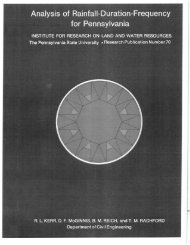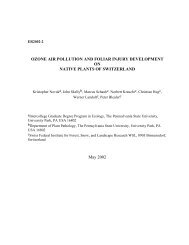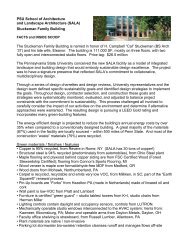Next-Generation Biofuels - Penn State Institutes of Energy and the ...
Next-Generation Biofuels - Penn State Institutes of Energy and the ...
Next-Generation Biofuels - Penn State Institutes of Energy and the ...
You also want an ePaper? Increase the reach of your titles
YUMPU automatically turns print PDFs into web optimized ePapers that Google loves.
26 NEXT-GENERATION BIOFUELS<br />
<br />
<br />
<br />
<br />
<br />
<br />
<br />
<br />
<br />
<br />
<br />
<br />
<br />
<br />
<br />
<br />
<br />
<br />
<br />
<br />
<br />
<br />
<br />
<br />
<br />
goal are barley <strong>and</strong> canola. Both can be grown as winter<br />
crops. If managed to optimize fertilizer efficiency, <strong>the</strong>y can<br />
also act as cover crops that reduce erosion <strong>and</strong> nitrogen<br />
leaching from <strong>the</strong> field (see Figure 8). Barley can be used<br />
for grain ethanol or combustion <strong>and</strong> (eventually) its<br />
straw can be processed into cellulosic ethanol. Canola<br />
is <strong>the</strong> most popular crop for biodiesel in Europe. <strong>State</strong>s<br />
should work with <strong>the</strong>ir Cooperative Extension <strong>of</strong>fices,<br />
Conservation Districts <strong>and</strong> o<strong>the</strong>r technical assistance<br />
providers to modify programs or develop new programs to<br />
help this happen.<br />
3<br />
Assure broad <strong>and</strong> effective use <strong>of</strong> best<br />
management practices for growing <strong>and</strong><br />
harvesting feedstocks.<br />
Geographically-relevant conservation best<br />
management practices (BMPs) should be established<br />
for <strong>the</strong> planting <strong>and</strong> harvesting <strong>of</strong> bi<strong>of</strong>uel crops,<br />
including crop residues <strong>and</strong> forest crops.<br />
Background: Given <strong>the</strong> possible environmental effects<br />
<strong>and</strong> opportunities presented by converting substantial<br />
l<strong>and</strong> areas to cropl<strong>and</strong> for feedstocks, states in <strong>the</strong> region<br />
need to establish systems to maximize nutrient reduction,<br />
preserve wildlife habitat <strong>and</strong> achieve o<strong>the</strong>r goals for Bay<br />
restoration. Some <strong>of</strong> <strong>the</strong>se actions will address how l<strong>and</strong> is<br />
chosen <strong>and</strong> crops are grown. O<strong>the</strong>rs will focus on <strong>the</strong> use<br />
<strong>of</strong> fertilizer <strong>and</strong> o<strong>the</strong>r nutrients, while still o<strong>the</strong>rs will deal<br />
with <strong>the</strong> management <strong>and</strong> protection <strong>of</strong> highly erodible<br />
l<strong>and</strong> <strong>and</strong> o<strong>the</strong>r sensitive areas.<br />
Each state will need to determine <strong>the</strong> mix <strong>of</strong> requirements<br />
<strong>and</strong> incentives to achieve <strong>the</strong> benefits <strong>of</strong> <strong>the</strong>se BMPs,<br />
recognizing that farmer <strong>and</strong> forester interest in bi<strong>of</strong>uels<br />
production may be an important catalyst for conservation.<br />
At a minimum, adequate funds need to be appropriated at<br />
<strong>the</strong> state level <strong>and</strong> provided by <strong>the</strong> federal government to<br />
establish or exp<strong>and</strong> BMP cost-share programs as well as<br />
conservation education <strong>and</strong> technical assistance support.<br />
<strong>State</strong>s should also consider establishing residue management<br />
assistance programs designed to help farm <strong>and</strong> forest<br />
l<strong>and</strong> managers <strong>and</strong> owners properly harvest, store <strong>and</strong><br />
transport cellulosic feedstocks for bi<strong>of</strong>uel production.<br />
4Establish or update state removal<br />
guidelines for crop residues <strong>and</strong> forest<br />
slash <strong>and</strong> provide incentives for <strong>the</strong>ir<br />
adoption.<br />
Crop residues such as corn stover <strong>and</strong> forest slash<br />
hold great promise as feedstocks for cellulosic<br />
<strong>and</strong> o<strong>the</strong>r next-generation bi<strong>of</strong>uels, but <strong>the</strong>re are<br />
concerns about <strong>the</strong> effects <strong>of</strong> <strong>the</strong>ir removal on<br />
long-term soil quality, erosion control, wildlife<br />
habitat <strong>and</strong> nutrient loadings to streams <strong>and</strong> <strong>the</strong><br />
Bay. Consequently, removal guidelines should be<br />
established to reflect soil type, climatic conditions<br />
<strong>and</strong> l<strong>and</strong> configuration, among o<strong>the</strong>r factors. In cases<br />
where existing guidelines were established before <strong>the</strong><br />
dem<strong>and</strong> for biomass feedstocks was a factor, such<br />
guidelines should be updated.







